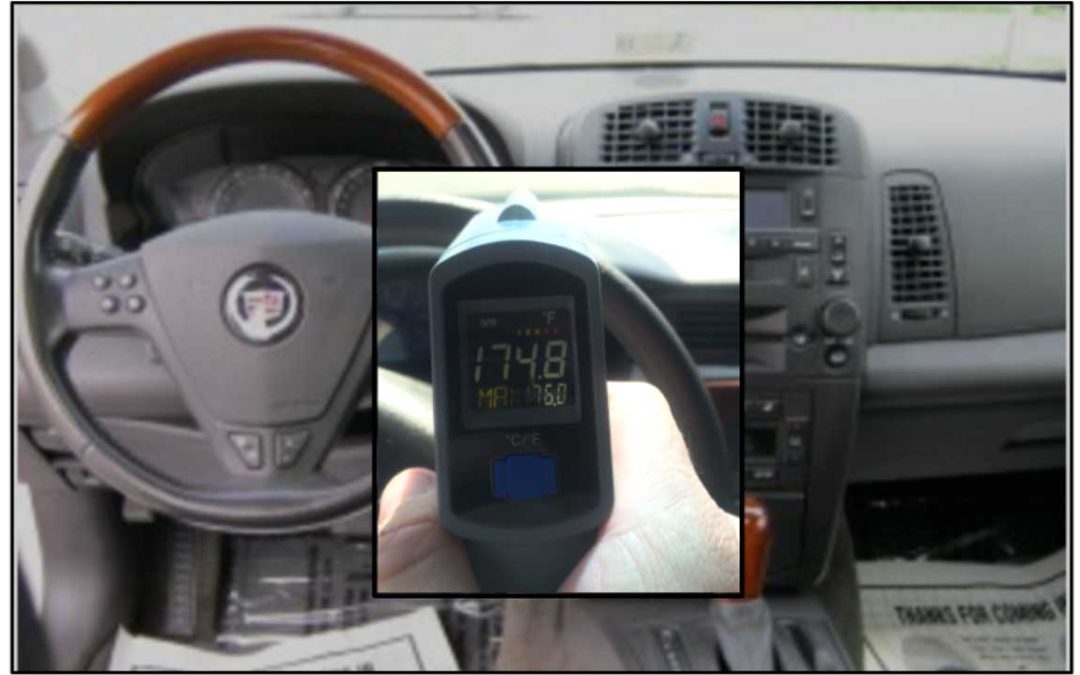Stepping into a minivan, large passenger van, or an SUV that has been sitting in the Arizona sun can be mighty uncomfortable to say the least. When it is a mild 70° on a sunny day, after only half an hour, the temperature inside a closed up vehicle can be as high as 104°. After an hour, it can reach 113°. When temperatures outside range from 80° to 100°, the temperature inside a vehicle parked in direct sunlight can quickly climb to anywhere between 130° to 172° Fahrenheit. Want to know how hot the interior of your van or SUV is when it’s a brisk 115° outside?
Before there is any chance of stopping the puddle that is developing between your back and the seat, the job of the air conditioning unit is to first reduce the heat that has accumulated in the oven that was once a van or truck. And then it must rise to the challenge of actually cooling the air.
The workhorse, powering this reduction in heat and aiding in the cooling, is of course, the engine. So imagine you’ve just gotten into your 15 passenger van. It’s 172° inside because the van has been sitting at the convenience store while you loaded up on goodies. You set off from the store and now need to climb up from the Valley floor here in Phoenix and into the mountains of Flagstaff, where you are hoping to find some relief from the summer inferno with eleven of your favorite baseball players, golfers, or family members….and their luggage. Ask yourself this: How is this van or SUV going to carry all of these people, expel the accumulated hot air, and cool the interior as well as the passengers? Not only does it have to work extra hard to climb the hills, but it also has to employ energy to try to cool the interior. This is where many engines wave the white flag. If you’ve driven from Phoenix to Flagstaff on any summer day, you’ve seen them—the broken down on the shoulder, hot as Hades, refusing to move even one more inch. And really, who can blame them?
Air conditioning is a terrific system, and if you are interested in the mechanics of it, see the article below. But the point is this: Being uncomfortable in the Arizona heat is not enjoyable for anyone, and in order to bring the temperatures from triple digits down to 60° or 70° is a monumental task and takes time and patience. And when that vehicle is a van or SUV loaded with hot bodies, adding to the internal temperature, the process is even more challenging. But it does happen.
In order to check that the air conditioning unit is functioning properly, the first thing our attendant will do is employ an infrared thermometer to measure the temperature of the air that is being produced by the vehicle’s a/c system. Mind you, the air will be colder when the vehicle is running and on the road, but if, at idle, the a/c system is blowing 50°, the unit is functioning properly. But even when driving and producing 40° air, it will take time to extract the 100° plus air from the interior and replace it with cooler air.
Want to get out of the heat? Need to rent a car, truck, van or SUV while traveling in the sometimes hot, but always beautiful state of Arizona? Call PHOENIX DISCOUNT Van & SUV Rental today at 602-826-5996
Kristen Hall-Geisler, writing for the website How Stuff Works, gives us a complete picture of how an automotive air conditioning system operates:
The High-pressure Side
All automotive air conditioning systems are (nearly) closed loops with a high-pressure side and low-pressure side. We’ll start with the high-pressure side as it leads from the engine to the passenger compartment:
Compressor: The compressor is a pump driven by a belt attached to the engine’s crankshaft. When the refrigerant is drawn into the compressor, it is in a low-pressure gaseous form. Once the gas is inside the pump, the compressor lives up to its name. The belt drives the pump, which puts the gas under pressure and forces it out to the condenser. Compressors cannot compress liquids, only gasses. You’ll see as we go through the system that there are other parts whose job it is to capture any water that accidentally makes into the AC loop.
Condenser: The condenser is basically a radiator, and it serves the same purpose as the one in your car: to radiate heat out of the system. The refrigerant enters the condenser as a pressurized gas from the compressor. The process of pressurizing the gas and moving it to the condenser creates heat, but air flowing around the twisting tubes of the condenser cool the refrigerant down until it forms a liquid again. Imagine steam cooling down and condensing back into water, and you’ve got the idea. The liquid refrigerant is now a high-pressure liquid and nearly ready to cool the car.
Receiver-Dryer: But first, the refrigerant needs to be prepped for the evaporator. As it moves out of the condenser, the liquid goes through a little reservoir installed in the line. This receiver-dryer contains desiccants, small granules that attract water. You’ve seen packets of desiccants in shoeboxes, where they do the same thing: attract water from the air to keep new shoes fresh and ready for your feet. (They’re usually labeled “Do not eat.”) In the receiver-dryer, they remove any water that has entered the system. If the water is allowed to remain and possibly form ice crystals, it can damage the air conditioning system.
That’s enough high-pressure for anyone, so let’s move on to the low-pressure side of the system.
The Low-pressure Side
Thermal Expansion Valve (TXV): Here, the system changes from the high-pressure side to the low-pressure side. If you were to touch this part of the system, you’d feel it change from hot to cold.
The high-pressure liquid refrigerant flows from the receiver-dryer through the expansion valve, where it is allowed to expand. This expansion reduces the pressure on the refrigerant, so it can move into the evaporator. The valve senses pressure and regulates the flow of refrigerant, which allows the system to operate steadily, but the moving parts of the valve can wear out and sometimes require replacement.
Some vehicles have an orifice tube rather than an expansion valve, but it serves the same purpose in allowing the refrigerant to expand and the pressure to be lowered before the liquid enters the evaporator. The orifice tube allows refrigerant to flow at a constant rate and has no moving parts, but it can become clogged with debris over time. Systems with an orifice tube automatically turn the AC system on and off to regulate the flow of refrigerant to the evaporator.
Evaporator: This is where the magic happens. While all the other parts of the system are located in the engine compartment, this one is in the cabin, usually above the footwell on the passenger side. It also looks like a radiator, with its coil of tubes and fins, but its job is to absorb heat rather than dissipate it.
Refrigerant enters the evaporator coil as a cold, low-pressure liquid, ideally at 32 degrees Fahrenheit (0 degrees Celsius), which is why you don’t want any water in the system. The refrigerant doesn’t freeze at this temperature, but it does have a very low boiling point. The heat in the cabin of the car is enough to make the R-134a in the evaporator boil and become a gas again, just like water turning back to steam. In its gaseous form, refrigerant can absorb a lot of heat.
The gas moves out of the evaporator — and out of the passenger compartment of the car, taking the heat with it. A fan blowing over the outside of the evaporator coil blows cool air into the passenger compartment. The refrigerant in gas form then enters the compressor, where it is pressurized and the whole process starts all over again.
If the system uses an orifice tube, there will be an accumulator between the evaporator and the compressor. An orifice tube sometimes lets too much refrigerant into the evaporator and it doesn’t all boil. Since the compressor cannot compress liquid, only gas, the accumulator traps any excess liquid before it can get into the compressor.
The evaporator also takes humidity out of the air in the car, which helps you feel cool. Water in the air condenses on the evaporator coil, along with dirt and pollen and anything else floating around in the cabin. When you stop the car and see water dripping underneath, it’s probably the water from the AC evaporator and nothing to worry about.
Kristen Hall-Geisler “How Automotive Air Conditioning Works” 23 February 2012.
HowStuffWorks.com. <http://auto.howstuffworks.com/automotive-air-conditioning.htm> 26 June 2016



